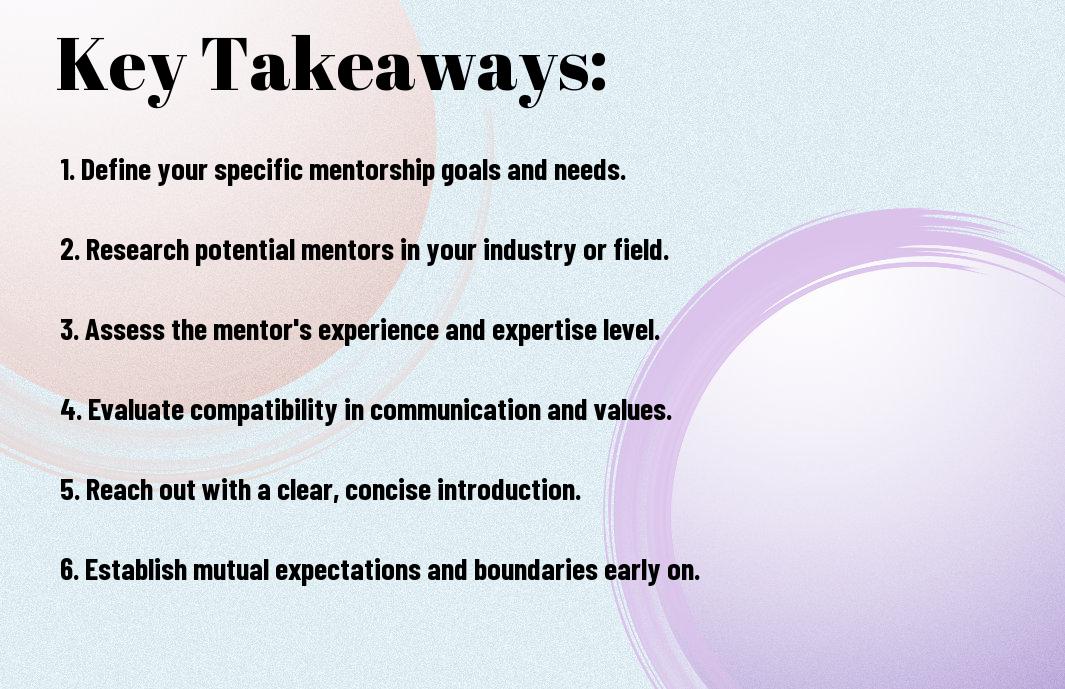It’s important to have the right guidance as you navigate your business journey, and finding a mentor can significantly impact your success. A business mentor can offer invaluable insights, share experiences, and help you refine your strategies. To get started, click here to explore what a business mentor is and how to find one that aligns with your goals. Your ideal mentor should resonate with your aspirations and provide the support you need to thrive in your career.
Key Takeaways:
- Identify Goals: Clearly define your professional goals to find a mentor who aligns with your aspirations.
- Network Actively: Leverage your existing networks and attend industry events to meet potential mentors.
- Assess Compatibility: Evaluate the mentor’s experience, values, and communication style to ensure a good fit.
- Seek Specific Expertise: Look for a mentor with knowledge and experience in your area of interest or business sector.
- Be Open to Feedback: Choose a mentor who provides constructive criticism and encourages your growth.

Understanding the Importance of a Business Mentor
A business mentor serves as a guiding force in your professional journey, providing insight, support, and encouragement that can significantly accelerate your growth. They not only share their experiences but also allow you to leverage their networks, helping you navigate challenges with greater confidence. A mentor can help refine your skills, clarify your goals, and provide accountability, which is invaluable in today’s competitive landscape.
Benefits of Mentorship
Any aspiring entrepreneur or established business owner can greatly benefit from mentorship. By fostering a relationship with a mentor, you gain access to invaluable advice, fresh perspectives, and proven strategies. These insights can lead to improved decision-making and ultimately enhance your business performance. Furthermore, mentorship often opens doors to networking opportunities that can propel your career forward.
Identifying Your Needs
One of the first steps in seeking a mentor is to clearly identify your specific needs. Understanding what aspects of your business or professional development you want to improve will help you find a mentor who aligns with your goals.
But it’s important to dig deeper into your needs by assessing your strengths and weaknesses. Reflect on the areas where you seek growth, be it strategic planning, financial management, or industry insights. This self-awareness will guide you in selecting a mentor whose expertise complements your aspirations, making the mentorship relationship more effective and meaningful in your business journey.
Characteristics of an Ideal Mentor
There’s a set of traits that defines an ideal mentor. You should look for someone who is not only knowledgeable but also approachable and empathetic. A good mentor guides you through challenges, provides constructive feedback, and encourages you to expand your horizons. Their ability to genuinely connect with you and adapt their mentoring style to suit your needs can make a significant difference in your professional development.
Industry Knowledge
Against a backdrop of ever-evolving industries, it’s crucial that your mentor possesses relevant industry knowledge. They should have practical experience and insights that align with your career goals. This expertise will help you navigate the complexities of your field and provide valuable guidance tailored to your unique situation.
Compatibility and Communication
Industry knowledge can only take your mentoring relationship so far. If you and your mentor don’t see eye to eye or struggle to communicate effectively, the partnership may fall flat. Finding someone with whom you can have open, honest discussions and who understands your perspective is key. Effective communication fosters trust and encourages sharing of ideas, making it easier to address challenges and set goals together.
Compatibility plays a significant role in the success of your mentor-mentee relationship. You’ll want a mentor whose values and work ethic resonate with yours. When you both share similar professional goals and interests, it sets the stage for productive conversations and collaboration. Additionally, differing views can stimulate growth and broader thinking, but these differences should be navigated with respectful communication to keep the relationship strong.
Where to Find Potential Mentors
To discover potential mentors, start by exploring various environments where experienced professionals congregate. Look into industry-specific events, educational programs, and community gatherings focused on your interests. Joining clubs and associations relevant to your field can also introduce you to individuals who have valuable insights and are willing to share their expertise. Utilizing both physical and virtual spaces will maximize your chances of connecting with the right mentor.
Networking Events
Behind every successful connection lies a well-attended networking event. These gatherings create opportunities for you to engage directly with people in your industry who may have the experience and perspective you seek. Prepare to ask thoughtful questions and showcase your passion, as these interactions can lead to meaningful mentorship relationships. Be proactive in following up with potential mentors you meet.
Online Platforms and Communities
Beside traditional networking, leveraging online platforms can expand your search for mentors. Social media channels, professional forums, and mentorship websites provide a wealth of resources and connections. By actively participating in discussions and seeking out individuals with complementary goals, you can forge relationships that may evolve into mentorship.
Online communities are a treasure trove for mentorship opportunities. Platforms like LinkedIn, specialized forums, and social media groups allow you to engage with experienced professionals at your convenience. Join relevant groups, contribute to discussions, and reach out directly to potential mentors whose experiences mirror your aspirations. This strategic approach helps you build a network of supportive individuals who are willing to guide you on your professional journey.
Approaching a Potential Mentor
Now that you’ve identified a potential mentor, it’s important to approach them thoughtfully. Start by introducing yourself and expressing your admiration for their work. Be clear about your intentions and how you believe their guidance could assist you in your journey. Keep the initial contact brief and respectful of their time; you want to spark their interest, not overwhelm them.
Crafting Your Message
An engaging message that captures your interest in mentorship is key. Clearly articulate your goals and the specific areas where you seek mentorship. Personalize your message by referencing their work and how it aligns with your aspirations. This shows sincerity and a genuine desire to learn from their experiences.
Building Rapport
Message your potential mentor in a way that fosters connection. Begin by finding common interests or experiences to discuss, which can create a more relaxed conversational tone. Ask thoughtful questions about their journey, allowing them to share insights that resonate with you. This initial interaction sets the stage for a more profound relationship as you demonstrate respect and appreciation for their expertise.
Your ability to build rapport can significantly enhance your chances of establishing a mentorship relationship. Be open and approachable during your interactions, allowing the conversation to flow naturally. Show genuine curiosity about their experiences and insights, as this reinforces your interest. Share relevant sections of your own journey to create mutual understanding. The more you connect on a personal level, the more likely your potential mentor will feel inclined to invest in your growth.

Establishing a Mentorship Relationship
Despite the potential challenges, establishing a mentorship relationship can be rewarding. You should aim to create a partnership built on mutual respect and trust. Both you and your mentor should share a clear understanding of your goals and how you can support one another. Take the time to invest in this relationship, as it can immensely benefit your personal and professional growth.
Setting Expectations
Around the beginning of your mentorship, it’s important to clarify your expectations. Discuss what you hope to achieve, the frequency of your meetings, and the types of feedback you value. By aligning your goals and methods from the start, you set a foundation for a productive and focused mentorship journey.
Maintaining Communication
Among the many aspects of mentorship, regular communication is vital for ongoing development. You should establish a schedule for check-ins, whether they are in person, over the phone, or via email. Being proactive in sharing updates on your progress helps your mentor offer timely advice and support.
Further, actively seeking feedback from your mentor is important for growth. Encourage open discussions about your challenges and successes, which fosters a supportive environment. Additionally, you can share relevant articles or insights that may benefit your mentor, promoting a two-way exchange. By prioritizing consistent communication, you deepen the connection and ensure that the mentorship remains dynamic and impactful.
Evaluating the Mentorship Experience
Many entrepreneurs overlook the importance of regularly evaluating their mentorship experience. It’s imperative for you to reflect on your interactions and identify whether your mentor’s guidance aligns with your business goals. Consider their contributions, communication style, and whether you feel supported in your growth. This evaluation will empower you to make informed decisions about your ongoing mentorship journey.
Measuring Progress
To effectively measure your progress, set clear goals at the beginning of your mentorship. Track the achievements you make and analyze how the guidance you receive influences your business decisions. Regularly assess whether you are meeting your objectives, and discuss these findings with your mentor to ensure you both remain aligned in your pursuits.
Knowing When to Transition
Behind every successful mentorship lies the delicate balance of growth and transition. You may reach a point where the guidance you receive no longer serves your evolving needs or where your goals shift dramatically. Recognizing these signs is vital for maintaining a fruitful mentorship experience.
Understanding the right moment to transition involves evaluating your current goals and the growth you’ve achieved with your mentor. Reflect on whether your relationship has evolved into one that still adds value or if you have outgrown it. You should feel empowered to seek new mentorship opportunities that better align with your ambitions, as this can open doors to further growth and development in your professional journey.
Final Words
Hence, finding the right business mentor involves understanding your specific needs, aligning with someone who possesses the experience you seek, and establishing a relationship built on trust and openness. Take the time to network, ask for recommendations, and evaluate potential mentors based on their expertise and compatibility with your goals. When you find the right fit, you will not only gain invaluable insights but also foster a partnership that enriches your professional journey.
Q: Why is having a business mentor important?
A: A business mentor can provide guidance, insight, and valuable experience that can accelerate your growth as an entrepreneur. They often help you navigate the complexities of running a business, avoiding common pitfalls, and identifying opportunities that you might not see on your own. Additionally, mentors can offer networking opportunities, emotional support, and accountability, all of which can be beneficial for achieving your business goals.
Q: What qualities should I look for in a business mentor?
A: When searching for a business mentor, it is necessary to consider several key qualities. First, look for someone with relevant experience in your industry or field. They should possess a wealth of knowledge and insights that can help you grow. Additionally, a good mentor should be a great communicator, able to convey ideas clearly and provide constructive feedback. Consider their willingness to invest time and resources into your development, as well as their interpersonal skills to ensure a good fit. Finally, a strong mentor should have a track record of success, demonstrating their ability to achieve results.
Q: How can I approach someone to be my business mentor?
A: Approaching a potential mentor requires a thoughtful strategy. Start by researching individuals who align with your industry and values, and who have the expertise you seek. When you reach out, be clear about your intentions; explain why you admire their work and how you believe they can help you. Make your request specific but respectful of their time; a casual coffee or virtual chat can be a good starting point. Show appreciation for their consideration, and be open to their response, whether they agree or not. Building a genuine connection and demonstrating your commitment to growth will help foster a potential mentorship relationship.





